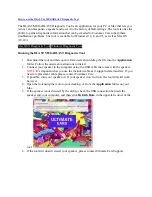
Summary of Important Safety Information for Operation (cont’d)
41
Use approved container
. Never pump fuel directly into engine at gas station. Static charge can build and
ignite fuel. Use an UL approved fuel container to transfer gas to the engine.
Running / hot engine
. A running engine is hot enough to ignite fuel. Never add fuel or remove gas cap if
engine is running or still hot. Stop the engine and allow to cool at least two minutes before adding fuel.
Heat / flames / sparks
. Stay away from sources of heat, flame, or sparks while adding fuel.
Don’t overfill
. DO NOT overfill the gas tank.
Fill to bottom of fill neck to allow for fuel expansion.
Replace cap
. Replace gas cap securely before starting engine.
Spills
. Clean up fuel spills immediately. Move generator away from spilled fuel on the ground. Wipe fuel
off engine and wait 5 minutes for excess fuel to evaporate before starting engine. Gas soaked rags should be
disposed of properly.
On skin / clothes
. If gasoline is spilled on your skin or clothes, change clothes and wash skin immediately.
Inspect fuel system
. Check fuel system on a regular basis. Look for signs of leaks, deterioration, chafed or
spongy fuel hose, loose or missing fuel hose clamps, damaged fuel tank, or a defective fuel shut-off valve.
Do not start generator until needed repairs have been completed.
Gasoline storage
. Store gasoline in a cool, dry place in an UL-approved, tightly sealed container.
Safety – During Use
Safety equipment / controls
. Always operate the generator with all safety covers, guards, and barriers in
place and in good working order, and all controls properly adjusted for safe operation.
Know how to stop
. Be thoroughly familiar with proper use of the equipment and all generator controls,
output receptacles, and connections. Know how to stop the generator quickly if needed.
Damaged
. Do not operate the generator with damaged, missing, or broken parts.
Carbon monoxide exhaust
. The running engine gives off carbon monoxide, a poisonous gas that can kill
you. You CANNOT smell it, see it, or taste it. If you start to feel sick, dizzy, or weak while using the
generator, shut off the engine and get to fresh air RIGHT AWAY. See a doctor. You may have carbon
monoxide poisoning.
Other exhaust dangers
. This product contains or emits chemicals known to the State of California to cause
cancer, birth defects or other reproductive harm. Avoid inhalation of exhaust.
Smoking/sparks
. Never smoke near the running generator, and never operate near sources of sparks or
flames.
Check output voltage
. Check output voltage to ensure the generator is working properly before connecting
loads to the generator. Failure to do so could result in damage to equipment powered by the generator and
possible injury to the individual. Do not adjust output speed of engine to change voltage. If voltage is not
within specified range, have generator repaired by factory authorized personnel.
Stabilize before connecting loads.
Start generator and let engine stabilize before connecting electrical loads.
Do not overload
. Do not overload the generator. Make sure that combined starting and running loads do not
exceed rated capacity of generator or damage will result.
Protect sensitive electronics
. Some electronic equipment, such as computers and audio/video equipment,
can be damaged by small fluctuations in the flow of power. Use a surge suppressor for any voltage-sensitive
electronic equipment you will be powering with the generator.
Wet conditions.
Do not operate the generator or handle any electrical equipment while standing in water,
while barefoot, while hands are wet or while in the rain or snow. Electric shock may result.
Ground fault circuit interrupter.
Always use a ground fault circuit interrupter (GFCI) protected extension
cord (or outlet, if generator is equipped) in damp or highly electrical conductive areas and on construction
jobsites to prevent electrical shock.
Electrical cords.
Use only UL-listed, outdoor-rated, three prong extension cords of the proper size. All
extension and appliance cords must be in good condition and not worn, bare, frayed, or otherwise damaged.
Use of inadequate or damaged electric cords can cause electric shock or fire.
Avoid contact
. Avoid contact with bare wires, terminals, connections, etc. while the unit is running.
Electric shock accident.
If an electric shock accident occurs, immediately shut down the source of electrical
power. If this is not possible, attempt to free the victim from the live conductor. Avoid direct contact with
victim. Use a nonconducting implement, such as a dry rope or board, to free the victim from the live
conductor. Apply first aid and get immediate medical help.
Hot muffler
. Never touch hot muffler, hot exhaust manifold, or engine cooling fins. Exhaust and engine parts
can be very hot and will burn you.
Moving parts
. Keep hands, feet, and apparel away from drive belts, fans, and other moving parts. Never
remove any drive belt or fan guard while the unit is operating.
Summary of Contents for 165601
Page 2: ...Hazard Signal Word Definitions 2 ...
Page 43: ...Generator Exploded View Rev O 3 Item s 165601 165603 165604 43 ...
Page 45: ...Generator Exploded View Rev O 3 Item s 165605 165606 165607 45 ...
Page 47: ...Control Panel Parts List Rev O 3 47 Item 165601 Item 165603 Item 165604 ...
Page 48: ...Control Panel Parts List Rev O 3 48 Item 165605 Item 165606 Item 165607 ...
Page 50: ...Generator Head Exploded Views Rev O 3 Item s 165601 165603 165604 165605 50 ...
Page 52: ...Generator Head Exploded Views Rev O 3 Item s 165606 165607 52 ...
Page 54: ...54 This page has intentionally been left blank ...
Page 56: ...56 Assembled by Northern Tool Equipment Company Inc Burnsville MN 55306 NorthernTool com ...
















































